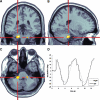Pharmacotherapy of vestibular and ocular motor disorders, including nystagmus
- PMID: 21461686
- PMCID: PMC3132281
- DOI: 10.1007/s00415-011-5999-8
Pharmacotherapy of vestibular and ocular motor disorders, including nystagmus
Abstract
We review current pharmacological treatments for peripheral and central vestibular disorders, and ocular motor disorders that impair vision, especially pathological nystagmus. The prerequisites for successful pharmacotherapy of vertigo, dizziness, and abnormal eye movements are the "4 D's": correct diagnosis, correct drug, appropriate dosage, and sufficient duration. There are seven groups of drugs (the "7 A's") that can be used: antiemetics; anti-inflammatory, anti-Ménière's, and anti-migrainous medications; anti-depressants, anti-convulsants, and aminopyridines. A recovery from acute vestibular neuritis can be promoted by treatment with oral corticosteroids. Betahistine may reduce the frequency of attacks of Ménière's disease. The aminopyridines constitute a novel treatment approach for downbeat and upbeat nystagmus, as well as episodic ataxia type 2 (EA 2); these drugs may restore normal "pacemaker" activity to the Purkinje cells that govern vestibular and cerebellar nuclei. A limited number of trials indicate that baclofen improves periodic alternating nystagmus, and that gabapentin and memantine improve acquired pendular and infantile (congenital) nystagmus. Preliminary reports suggest suppression of square-wave saccadic intrusions by memantine, and ocular flutter by beta-blockers. Thus, although progress has been made in the treatment of vestibular neuritis, some forms of pathological nystagmus, and EA 2, controlled, masked trials are still needed to evaluate treatments for many vestibular and ocular motor disorders, including betahistine for Ménière's disease, oxcarbazepine for vestibular paroxysmia, or metoprolol for vestibular migraine.
Figures




Similar articles
-
Pharmacotherapy of vestibular disorders and nystagmus.Semin Neurol. 2013 Jul;33(3):286-96. doi: 10.1055/s-0033-1354594. Epub 2013 Sep 21. Semin Neurol. 2013. PMID: 24057832 Review.
-
Pharmacological advances in the treatment of neuro-otological and eye movement disorders.Curr Opin Neurol. 2006 Feb;19(1):33-40. doi: 10.1097/01.wco.0000196156.00481.e1. Curr Opin Neurol. 2006. PMID: 16415675 Review.
-
Current treatment of vestibular, ocular motor disorders and nystagmus.Ther Adv Neurol Disord. 2009 Jul;2(4):223-39. doi: 10.1177/1756285609103120. Ther Adv Neurol Disord. 2009. PMID: 21179531 Free PMC article.
-
Pharmacotherapy of vestibular and cerebellar disorders and downbeat nystagmus: translational and back-translational research.Ann N Y Acad Sci. 2015 Apr;1343:27-36. doi: 10.1111/nyas.12774. Ann N Y Acad Sci. 2015. PMID: 25903394 Review.
-
Advances in pharmacotherapy of vestibular and ocular motor disorders.Expert Opin Pharmacother. 2019 Jul;20(10):1267-1276. doi: 10.1080/14656566.2019.1610386. Epub 2019 Apr 27. Expert Opin Pharmacother. 2019. PMID: 31030580 Review.
Cited by
-
Update on the pharmacotherapy of cerebellar and central vestibular disorders.J Neurol. 2016 Apr;263 Suppl 1:S24-9. doi: 10.1007/s00415-015-7987-x. Epub 2016 Apr 15. J Neurol. 2016. PMID: 27083881 Free PMC article. Review.
-
Consensus Paper: Latent Autoimmune Cerebellar Ataxia (LACA).Cerebellum. 2024 Apr;23(2):838-855. doi: 10.1007/s12311-023-01550-4. Epub 2023 Mar 29. Cerebellum. 2024. PMID: 36991252 Free PMC article.
-
Voltage-gated calcium channels in genetic epilepsies.J Neurochem. 2024 Dec;168(12):3853-3871. doi: 10.1111/jnc.15983. Epub 2023 Oct 11. J Neurochem. 2024. PMID: 37822150 Free PMC article. Review.
-
Secondary autoimmune immune ear disease (AIED): a systematic review and meta-analysis on vestibular manifestations of systemic autoimmune and inflammatory disorders.Clin Rheumatol. 2023 Oct;42(10):2747-2759. doi: 10.1007/s10067-023-06674-w. Epub 2023 Jun 28. Clin Rheumatol. 2023. PMID: 37380912
-
Transition from downbeat to upbeat nystagmus caused by 4-aminopyridine.J Neurol. 2013 May;260(5):1426-8. doi: 10.1007/s00415-013-6907-1. Epub 2013 Apr 18. J Neurol. 2013. PMID: 23595790 No abstract available.
References
-
- Neuhauser HK. Epidemiology of vertigo. Curr Opin Neurol. 2007;20:40–46. - PubMed
-
- Brandt T, Dieterich M, Strupp M. Vertigo and dizziness—common complaints. London: Springer; 2005.
-
- Strupp M, Cnyrim C, Brandt T. Vertigo and dizziness: Treatment of benign paroxysmal positioning vertigo, vestibular neuritis and Menère’s disease. In: Candelise L, editor. Evidence-based Neurology—management of neurological disorders. Oxford: Blackwell Publishing; 2007. pp. 59–69.
-
- Leigh RJ, Zee D. The neurology of eye movements. 4. Oxford: Oxford University Press; 2006.
-
- Straube A. Therapeutic considerations for eye movement disorders. Dev Ophthalmol. 2007;40:175–192. - PubMed
Publication types
MeSH terms
Grants and funding
LinkOut - more resources
Full Text Sources
Other Literature Sources
Medical

